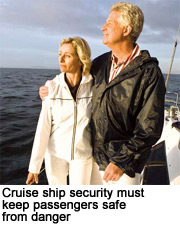Surf. Sun. Fun. Cruise ships offer all the above, along with food, lodging and transportation, for the ultimate travel experience.Cruise ships promise the allure of exotic locales, which are reached by crossing isolated bodies of water. Any mishap, be it weather, equipment failure or pirates, would doom the ship. As tourism booms, cruise ships launch cutting-edge solutions to preserve the lives of...
Surf. Sun. Fun. Cruise ships offer all the above, along with food, lodging and transportation, for the ultimate travel experience.
Cruise ships promise the allure of exotic locales, which are reached by crossing isolated bodies of water. Any mishap, be it weather, equipment failure or pirates, would doom the ship. As tourism booms, cruise ships launch cutting-edge solutions to preserve the lives of passengers and crewmembers.
These floating cities carry anywhere from 3,000 to 10,000 passengers, making security an utmost concern. Cruise ship operators need to keep passengers happy and out of harm's way. Both are tall orders, complicated by the ship's numerous decks and the large onboard population.
IP has boarded the newest cruise ships, such as the world's biggest Oasis of the Seas. While greenfield applications have built-in network infrastructure, retrofitting older ships with cramped quarters is trickier.
Convergence has clear benefits, but issues lurk beneath the surface. If a ship-wide network crashes, it could bring down all integrated systems, leaving the ship with no communications, security or life safety. The risk of "overintegration" requires subsystems to have stand-alone functionality, should the network go down.
As tourism booms, cruise ships launch cutting-edge solutions to preserve the lives of passengers and crewmembers. Cruise ships allow passengers to get away from the stresses of everyday life. The idyllic seafaring environment provides relaxation, but also presents unique security concerns.
A cruise ship covers all traveler needs, so guests can kick back and relax. An estimated 16.8 million people took cruises in 2008, a significant increase from about 900,000 passengers in 1983.
To meet demand, cruise lines are ramping up production. At least 15 vessels will  launch in 2010, each worth about US$250 million to $1 billion, making cruise tourism a multibillion-dollar industry.
launch in 2010, each worth about US$250 million to $1 billion, making cruise tourism a multibillion-dollar industry.
The boom in cruises is accompanied by increased regulation. Mandates, such as the Safety of Life at Sea Convention for ships, ports and government agencies, require them to "detect security threats and take preventative measures against security incidents affecting ships or port facilities used in international trade."
With a cruise ship resembling a small city at sea, security is a top priority. "The largest cruise companies generally have well-developed internal organizations, where safety and security sit as a key corporate department that is focused on continually assessing and addressing these risks," said David Fairnie, Global Ports Solutions Director for G4S. "The solutions they apply to prevent risk from materializing take the form of combining people, process and technology to mitigate the risk — never one in isolation."
Cruise ship security has parallels to the hospitality market, but the ever-changing marine environment introduces unseen issues. "There's an entire set of circumstances that are different when sailing on water in the middle of the ocean, compared to being on land with access," said Bob Swoope, VP of Sales for Alarm Lock Systems.
Terrorism
Deliberate organized attacks against densely packed cruise ships loom as an all-too-real threat. While there have been few attacks on passenger ships, cruise ships are mindful of potential hazards, such as hijacking or dirty bombs.
Cruise ships sail with detection equipment onboard expressly for screening. "Explosives, weapons and general contraband are three threats," said Brook Miller, VP of Smiths Detection. "Things like explosive devices, explosive  components, guns or knives are not useful other than being dangerous things. Those threats are addressed in the screening process."
components, guns or knives are not useful other than being dangerous things. Those threats are addressed in the screening process."
Different ports of call present varying risk levels. "Cruise ships might dock at uncontrolled or unfriendly environments, and may become easy targets for terrorist attacks," said Cosimo Malesci, cofounder and VP of Marketing for Fluidmesh. "If you take a cruise ship to the Miami harbor and blow it up, it can cause big damage."
Pirates
Pirates are among the most colorful characters at sea, embodied by Captain Hook and Jack Sparrow. Their real-life counterparts have evolved as more menacing predators, wielding automatic weapons and speedy getaway boats.
Pirates pose the biggest risk to shipping vessels or tankers, but affect passenger vessels. "Piratical attacks off the Horn of Africa constitute a threat to the lives and welfare of the citizens and seafarers of many nations," wrote the National Security Council in a 2008 report. "Nearly 12 percent of the world's petroleum passes through the Gulf of Aden, which is one of the world's most important waterways."
The attacks come at a steep price. "Shipping interests typically pay ransoms in cash ranging from $500,000 to $2 million, with the overall income from piracy  ransoms estimated to exceed $30 million in 2008," read the National Security Council report.
ransoms estimated to exceed $30 million in 2008," read the National Security Council report.
This increased risk has resulted in more security. "In the last 18 months, there has been a rise in investment in training people and equipping vessels to better handle the risks posed by piracy," Fairnie said.
Anti-piracy procedures include crisis response to secure the vessel from piratical boarding attempts; evacuation or passenger management; and use of nonlethal sonic weapons to disrupt or deter attempts to board. "However, many companies have decided not to sail through high-risk areas in order to mitigate the risks of piracy attacks," Fairnie said.
In the April 2009 hijacking of the Maersk Alabama, the crew used its anti-piracy training to stop the Somali pirates from controlling the freighter. "A video surveillance camera system alone is not going to prevent pirates from boarding a ship, but an integrated security system incorporating radar, thermal imaging, communications and defensive countermeasures just might give the ship's crew a fighting chance," said James Ionson, CEO of Oncam Global.
For the Maersk Alabama, the pirates kidnapped the captain but did not secure a ransom. "The US Navy used cameras onboard its P3 Orion and Scan Eagle unmanned aerial vehicle to identify how many pirates were onboard and what armament they had, and to monitor the ship's progress toward port," Ionson said. "Snipers took out the three hijackers, leading to the dramatic rescue of Captain Phelps."
Smuggling
Passengers are welcome onboard ships, but stowaways or controlled substances are not. Maintaining this delicate balance requires careful oversight and technology.
"At many different ports of call, the cruise ships need to make sure they are not  transporting contraband, weapons or threat items from one place to the next," Miller said. "It's like a movable airport, with a high concentration of people and equipment in one very small area."
transporting contraband, weapons or threat items from one place to the next," Miller said. "It's like a movable airport, with a high concentration of people and equipment in one very small area."
The process of embarking and disembarking passengers presents the highest risk of stowaways or illegal substances being transported. "This risk is usually addressed by a clear management process which incorporates controlled passenger routing, documentation checks and profiling — combined with security technology such as screening of baggage, stores and passengers — using walk-through and handheld metal detectors and X-ray systems, operated by trained security personnel," Fairnie said. The boarding phase is coordinated by ship personnel, along with outsourced security professionals landside, he said.
Environmental Hazards
The high seas present challenges to seafarers. Unexpected natural disasters, such as ice and flash flooding, must be accounted for, said Johannes Rietschel, founder and CEO of Barix.
The ship it self is unlike a land-based installation. "Some unique concerns cruise ships have are highly integrated systems, severe environmental factors, challenging cable runs and cramped equipment room spaces," said Rodger von Kries, VP of Technomad.
Limited ship space results in a tight fit for passengers and equipment. "Closed compartments and watertight doors pose challenges for installation," Malesci said.
Cruise ships must communicate clear messages to passengers throughout the  vessel. "In our view, zoning is especially important on a vessel where you have many decks, corridors and limited visibility," Rietschel said. "If something rocks the boat, there needs to be a way to get precise instructions out quickly, and these instructions might differ for various parts of the vessel."
vessel. "In our view, zoning is especially important on a vessel where you have many decks, corridors and limited visibility," Rietschel said. "If something rocks the boat, there needs to be a way to get precise instructions out quickly, and these instructions might differ for various parts of the vessel."
In the event of system malfunction, a cruise ship features multiple backup systems. "It's similar to how hospitals run power," Malesci said. "Usually on a ship, everything is doubled for power, water or electrical systems."
Close Quarters
Passenger ships cater to a distinct demographic. "Cruise ships tend to attract an older clientele, many of whom have existing health problems, and so crew must be able to respond rapidly to heart attacks, strokes or even ordinary seasickness with appropriate medical treatments," Ionson said.
A real threat for an onboard population would be epidemics. "Some threats would be to health environments," Swoope said. "It could be illnesses."
Some threats are universal, whether on land or at sea. "Ship operators are concerned with occurrences of such shipboard incidents as missing persons,  accidents involving passengers and crew (legitimate and fraudulent), and theft," Ionson said.
accidents involving passengers and crew (legitimate and fraudulent), and theft," Ionson said.
Cruise ship passengers could become targets in foreign countries. "In the Bahamas, the harbor had problems of thieves attacking tourists leaving cruise ships," Malesci said. "With cameras, the police could keep tabs on the thieves."
Accidents aboard cruise ships could result in lawsuits. "You have liability for cruise ship operators," said Erik Laurence, VP of North Asia, Verint Systems. "If someone claims they fell and hurt themselves and blames the operator, reviewing the video can help in many cases."
Cruise ships watch out for passenger safety. "For areas around decking or the pool, you can detect if there's a hazard somewhere on the ship and protect the owners from being sued," said Brian Lane, Senior Product Manager for Spectra, Pelco (a Schneider Electric company).
A cruise ship faces hazards common to hospitality and airports, along with unique environmental challenges. While being at sea presents danger, cruise ships take safety and security seriously by deploying holistic solutions.